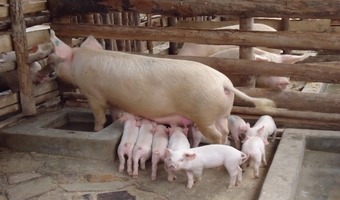

One important thing to keep in mind with pigs is that they are both very strong and very curious. Thus, it’s important to make sure that the indoor space you’re providing them with is strong enough to withstand a pig nose or the bulk of their weight. Some suggest using a building made of concrete or reinforced metal rather than wood as they could potentially destroy both wood and pole barns if not reinforced and secured properly. If you do opt for a wooden structure, don’t skimp on structural support. Pigs have been known to damage metal siding, leaving dangerously sharp edges that residents can get injured on.
The flooring should not be concrete. Dirt or another slip-resistant material is crucial since slips and falls can have devastating health effects on a pig’s oversized body. If the indoor living space floor is concrete, you should layer a half a foot of dirt onto the concrete floor or use rubber mats (which are safer than concrete, but will require quite a bit of daily cleanup). Bare concrete and hardwood floors are not acceptable for pigs. Pigs have been known to fall through wooden floors. If you use dirt, it must be regularly maintained and any divots must be filled in to prevent foot injuries.
Ideally, you should provide an abundant amount of dry and clean straw in a pig’s indoor living space. They love nesting and using long straw as bedding. You must remove and replace all moist and soiled straw to prevent serious health risks to pigs. There are products you can spread on wet areas such as hydrated lime alternatives to keep the living space free of moisture. If you cannot access straw, you can potentially use other clean and replaceable materials such as wood shavings, but straw is best and most enjoyable for them. Exhaust fans with locking shutters are very effective at keeping barns well-ventilated and dry.
Hot Considerations
A pig’s indoor living space needs to be waterproof and free of drafts, in both warm and cold conditions. Because they cannot sweat, pigs are highly prone to dangerous heat exhaustion. Therefore, you need to make sure that they can stay cool indoors in the summer. If necessary, you can use water misting fans, but you have to make absolutely sure you aren’t getting their living space too moist. Even basic circulating fans can be kept on automatic thermostats to keep residents comfortable, but you must ensure that all cables are safely secured!
Cold Considerations
In the cold, you have to make sure that the barn is ventilated as well, because humidity can quickly build up in a warm barn and cause dangerous pneumonia outbreaks and skin infections in a herd. However, pigs also need to stay warm in the winter! If your barn is properly insulated, a pig’s body (especially a group of pigs in one area) can provide a good deal of warmth. You will most likely be able to keep healthy adult pigs comfortably warm simply by giving them ample straw in cold temperatures and the opportunity to sleep near each other. Pigs enjoy using straw to build giant nests that they can burrow into. On a cold day, you may find all of your pig residents completely buried in straw.
 Contact Jaguza Support
Contact Jaguza Support